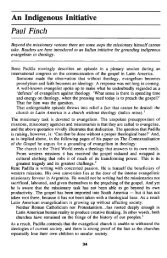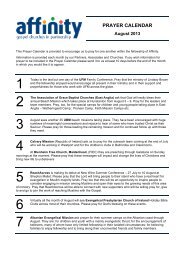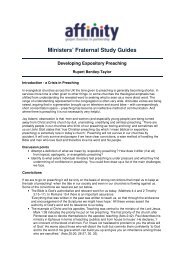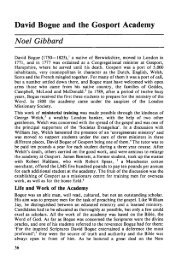The Image of God and Holiness - Affinity
The Image of God and Holiness - Affinity
The Image of God and Holiness - Affinity
Create successful ePaper yourself
Turn your PDF publications into a flip-book with our unique Google optimized e-Paper software.
'What <strong>God</strong> essentially is, Christ makes manifest'.16<br />
Christ is eternally the image <strong>of</strong> <strong>God</strong>; he can never be not<br />
the image. He is the image <strong>of</strong> <strong>God</strong> in his pre-incarnate<br />
state (Heb 1: 3) also in the incarnation (ColI: 15; 2 Cor 4:4).<br />
He is the image inherently; we, derivatively. He is the<br />
<strong>Image</strong> <strong>of</strong> <strong>God</strong>; we are created in that image. In the<br />
incarnation we see striking evidence <strong>of</strong> man being made<br />
in <strong>God</strong>'s image, for how could <strong>God</strong> have revealed himself<br />
fully in his Son if there were not correspondence between<br />
our nature <strong>and</strong> <strong>God</strong>'s He is the 'facsimile' <strong>of</strong> <strong>God</strong> <strong>and</strong><br />
also the 'prototype' <strong>of</strong> humanity within the <strong>God</strong>head. 17<br />
In Christ being fully man <strong>and</strong> fully <strong>God</strong> we have the<br />
answer to Calvin's conundrum: does the knowledge <strong>of</strong><br />
<strong>God</strong> or <strong>of</strong> ourselves come first In Christ we find both the<br />
knowledge <strong>of</strong> <strong>God</strong> <strong>and</strong> <strong>of</strong> ourselves, true <strong>God</strong> <strong>and</strong> true<br />
humanity.<br />
Christ was <strong>God</strong> <strong>and</strong> fully obeyed <strong>God</strong>. <strong>The</strong>re was never<br />
any possibility <strong>of</strong> his sinning <strong>and</strong> no possibility therefore<br />
<strong>of</strong> there being any breach between the narrow <strong>and</strong> broad<br />
image. His work is called, in Romans 5:18, his 'one act <strong>of</strong><br />
righteousness' (henos dikaiwmatos). He maintained<br />
throughout his life bur especially <strong>and</strong> characteristically at<br />
the cross his love for <strong>and</strong> obedience to <strong>God</strong> <strong>and</strong> did so<br />
from the heart (John 4:34; 8:29; 17:4; Heb 10:7). Thus a<br />
perfect image <strong>of</strong> <strong>God</strong> was maintained <strong>and</strong> a perfect<br />
righteousness wrought to be 'reckoned' through faith to<br />
those who believe. <strong>The</strong> righteousness <strong>of</strong> <strong>God</strong> as man, that<br />
is the righteousness <strong>of</strong> Christ, should perhaps be seen not<br />
as a substance or a faculty or even a quality but as an act,<br />
the act <strong>of</strong> obedience which Adam failed to <strong>of</strong>fer <strong>God</strong>, an<br />
act that was human bur <strong>of</strong> infinite value because also<br />
divine. It is perfect love which is not static but dynamic,<br />
active, the expression <strong>of</strong> authentic faith or trust. By that<br />
act all who believe are constituted righteous, by<br />
imputation, by federal relation to Christ - made what<br />
they are not by nature.<br />
In Christ's being the image <strong>of</strong> <strong>God</strong> we see also the goal <strong>of</strong><br />
regeneration: to be conformed to his likeness (Rom 8:29)<br />
<strong>and</strong> to be like him - 'just as we have borne the image <strong>of</strong><br />
the man <strong>of</strong> dust, we shall also bear the image <strong>of</strong> the man<br />
<strong>of</strong> heaven' (1 Cor 15:49; cf 2 Cor. 3: 18; 1 John 3:2). In<br />
Spring 2006<br />
Christ we are renewed in righteousness, holiness <strong>and</strong><br />
knowledge. <strong>The</strong> image <strong>of</strong> <strong>God</strong> in this sense is dynamic<br />
not static. To 'image' <strong>God</strong> is to live a life <strong>of</strong> love,<br />
imitating <strong>God</strong>. <strong>The</strong> goal <strong>of</strong> redemption is to be like <strong>God</strong>.<br />
What then should the church do<br />
1. Remember that (a) some appearance/image is<br />
inevitable as the genuine expression <strong>of</strong> reality; not<br />
artificially projected but the outshining <strong>of</strong> our being <strong>and</strong><br />
behaviour. If I appear competent/wise/loving/generous it<br />
should be because I really am, not because I am 'putting<br />
it on', but (b) 'image' is wrong when created consciously<br />
to obscure reality or project an alternative or even<br />
contrary <strong>and</strong> therefore deceptive 'persona'. This is the<br />
essence <strong>of</strong> hypocrisy.<br />
2. <strong>Image</strong> <strong>and</strong> reality will never wholly coincide in this<br />
life; perfect integrity is possible only in heaven.<br />
3. Christians should be able to 'dare to be sinners' with<br />
each other, acknowledging what we are though not<br />
glorying in it, <strong>and</strong> not feeling the need to project<br />
perfectionist images. We fear <strong>God</strong> not man. Our attitude<br />
should be 'I do not fear your condemnation because<br />
although I am not perfect I am right with <strong>God</strong>.' We do<br />
not glory in our sins but we know that what counts is<br />
that the blood <strong>of</strong> Jesus has cleansed us from them all.<br />
4. Be careful to try not to project or impose any images<br />
in preaching <strong>and</strong> church life. Looking at your life or<br />
church, <strong>and</strong> listening to your sermons, what would people<br />
think 'justifies' Even if we preach the gospel <strong>of</strong><br />
justification through faith by grace alone, what are people<br />
hearing <strong>and</strong> seeing Are we pressurising people to<br />
conform on inessentials Dr. Lloyd-Jones tells a story <strong>of</strong> a<br />
man who was converted. He had a big 'h<strong>and</strong>lebar'<br />
moustache. One day the Doctor was indignant to see that<br />
this man's moustache had gone. He thought some<br />
busy-body Christian had been telling him that 'Christians<br />
do not have moustaches like that'. That was not the way<br />
<strong>of</strong> sanctification. Francis Schaeffer used to say, 'You<br />
cannot be the Holy Spirit for someone else'. What<br />
untealistic images do we project <strong>and</strong> what unbiblical<br />
st<strong>and</strong>ards do we impose Preachers in particular may do<br />
so unwittingly - by their style more than by their 'substance'.<br />
15









